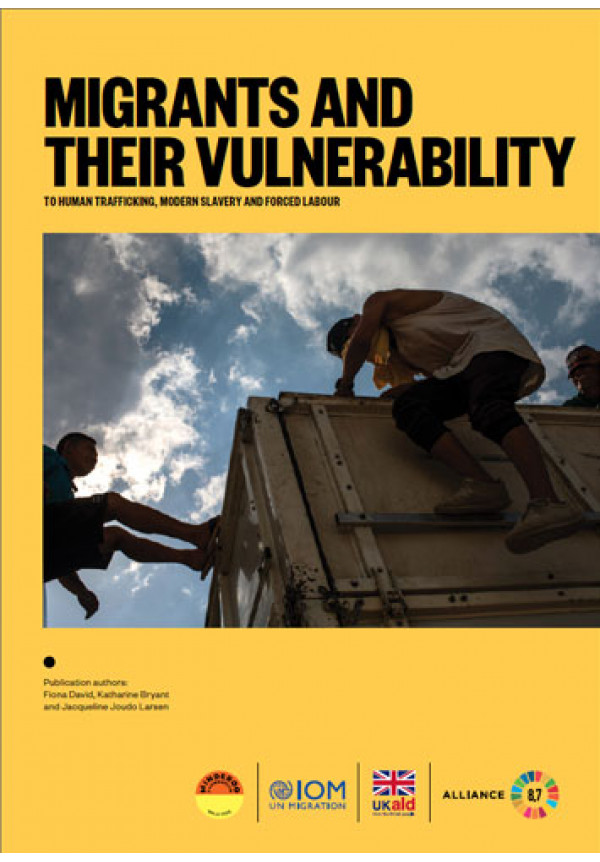
Migrants and their Vulnerability to Human Trafficking, Modern Slavery and Forced Labour
What makes migrants vulnerable to human trafficking and associated forms of exploitation and abuse? A new study, undertaken by Minderoo Foundation’s Walk Free initiative and IOM, examines the connection between migration and modern slavery, and focuses on which migrants are most vulnerable, and in what circumstances, to modern slavery.
The report explores various sites of vulnerability where migrants are particularly susceptible to human trafficking, forced labour and modern slavery. These include private dwellings, border crossings, irregular migration routes and conflict zones. The report illustrates that migrants are most vulnerable to exploitation in situations where the authority of the State and society are unable to protect them. It also analyses the characteristics of victims that are thought to contribute to their vulnerability. In addition, the study explains some characteristics of offenders, including worldviews that allow them to rationalize the exploitation of others. Lastly, the study looks at examples of enabling environments or contexts, such as restrictive immigration policies, that engender or exacerbate vulnerability.
Prepared for the Alliance 8.7 Action Group on Migration, the report examines the recent research literature through a crime prevention lens in order to identify a set of salient features that can help understand the relevant connections between migration and vulnerability to forced labour, human trafficking and modern slavery.
This study was made possible through funding provided by the Government of the United Kingdom through UK aid.
Read More
- FAST FACTS
- EXECUTIVE SUMMARY
- Where are migrants most vulnerable?
- Which migrants are most vulnerable?
- What enables migrants to be abused and exploited?
- What about existing government protections for migrants?
- Recommendations
- Recommendation 1: Increase protections for victims and vulnerable migrants
- Recommendation 2: Reduce capacity and opportunity for potential offenders
- Recommendation 3: Increase capacity and focus of guardians and first responders
- Recommendation 4: Focus research efforts on filling critical gaps in knowledge
- INTRODUCTION
- METHODOLOGY
- KEY FEATURES OF THE KNOWLEDGE BASE
- Methods of studies
- Thematic coverage
- Geographic focus
- Economic sector or purpose of exploitation
- Sites of vulnerability
- SITES OF VULNERABILITY IN THE MIGRATION PROCESS
- Areas beyond the reach of state protection
- Private dwellings
- Private businesses
- Border crossings
- Irregular migration routes
- Displacement sites and refugee camps
- Conflict zones
- Natural disasters
- Ships
- Rural areas
- Commercial sex establishments.
- VICTIM CHARACTERISTICS
- Children and youth
- Gender
- Visa status
- Knowledge and attitude toward migration
- Secondary displacement
- Repeat exploitation
- Length of travel
- Sexual orientation and identity
- Language ability
- Drug or alcohol addiction
- Health
- Poverty
- Education
- Necessity to support dependents
- Abusive or unstable family background
- Homelessness or lack of family support
- Cultural norms
- Lack of a local support network
- Caste status
- Globalization and inequality
- Discrimination against migrants
- OFFENDER CHARACTERISTICS
- Typologies
- Offender motivations
- Perception
- Resources relevant to offending
- GUARDIAN CHARACTERISTICS
- Gaps in responses
- Gaps in legislation
- Gaps in social protections and labour rights
- Non-recognition of foreign qualifications
- Restrictive immigration policies and weak migration governance structures
- Barriers to collective bargaining
- State-imposed forced labour
- Lack of political will or capacity to respond
- Conflict and natural disasters
- Corruption
- Complexity of the crime types
- Stereotypes and gaps in understanding
- Discrimination and prejudice
- ANALYSIS AND RECOMMENDATIONS
- Which migrants are vulnerable, when and in what circumstances?
- Pre-migration
- In transit
- At destination
- On return
- Addressing the intersections of risk
- Recommendation 1: Increase protections for victims and vulnerable migrants
- Recommendation 2: Reduce capacity and opportunity for potential offenders
- Recommendation 3: Increase capacity and focus of guardians and first responders
- Recommendation 4: Focus research efforts on filling critical gaps in knowledge
- ATTACHMENT A: RESEARCH PROTOCOL
- ATTACHMENT B: LIST OF COUNTRIES OR PLACES AND NUMBER OF STUDIES FOUND
- ATTACHMENT C: LIST OF COUNTRIES OR PLACES WITH NO STUDIES LOCATED
- BIBLIOGRAPHY
- ENDNOTES